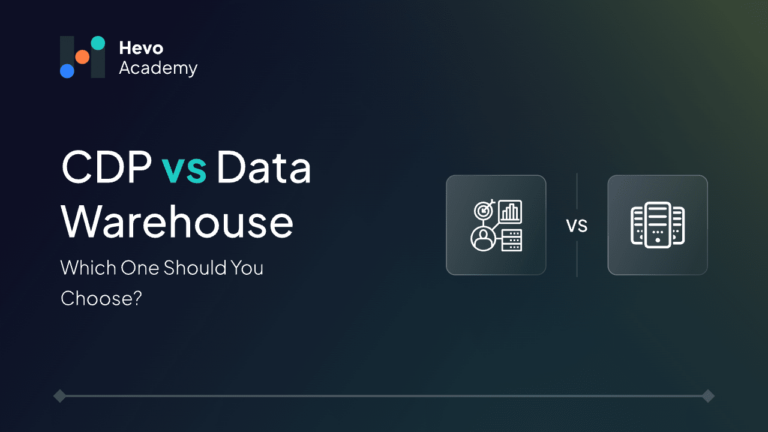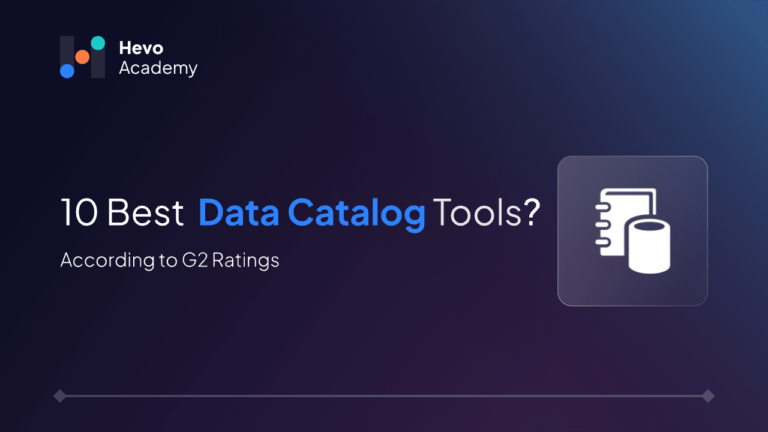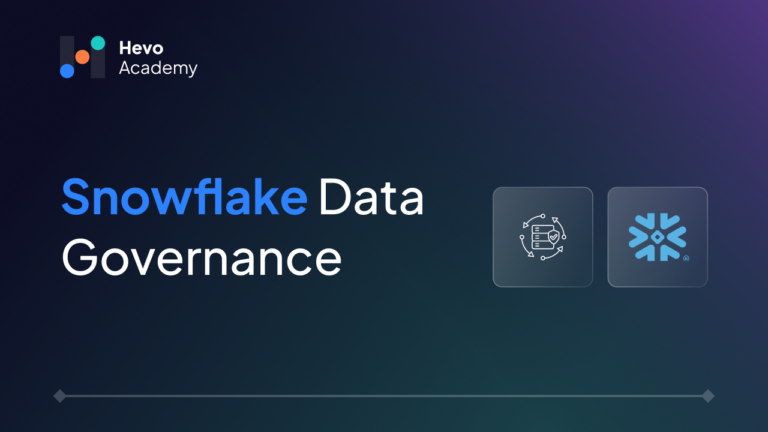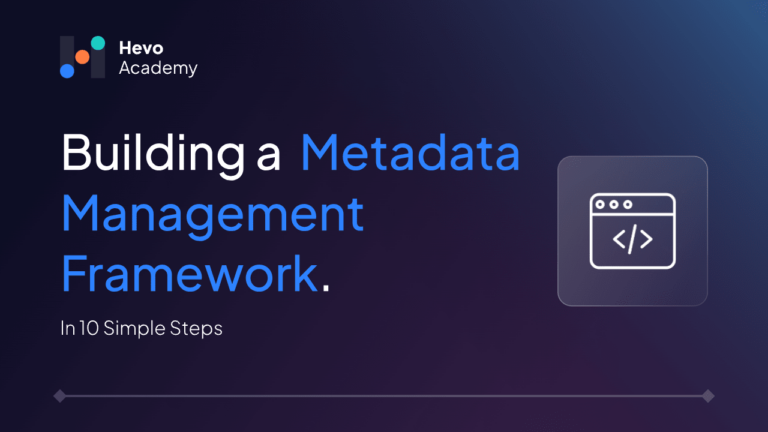In the modern world, which is characterized by constant changes in business conditions, the key to success is the use of customer data. This blog aims to present what distinguishes a Customer Data Platform (CDP) and Data Warehouse as being significant tools in corporate success. While CDPs are used mostly to handle real-time customer data for personalization, Data Warehouses collect data that are used with advanced analytics for the long term. Knowing these strengths would help enterprises choose a solution that will assist them in solving a problem, creating an immediate call to action for consumers or analytically making business decisions based on deep analysis of Big Data.
Table of Contents
This comparison of CDP vs Data Warehouse will highlight how these two solutions cater to different business needs.
What is a Customer Data Platform (CDP)?
The Customer Data Platform or CDP is defined as a current system that compiles data from a customer, verifies, and integrates data to form a single customer profile. It also ensures organizations propose solutions that involve the customer by enabling organizations to share relevant customer information between the marketing, customer support, and analytics tools. CDP makes it easier for the developers, product managers, and marketers to get access to real-time data without requiring layers of technical integration that might cause degradation in data quality, governance, and security while at the same time decreasing the amount of engineering work needed to make it happen and allowing for better engagement of the customers.
Benefits of a Customer Data Platform (CDP)
- Allows ease of access to customers’ information to non-financial teams in real-time.
- Enhances customer databases across all aspects of marketing and technology communication platforms.
- Reduces the complexities of data management and improves security.
- Saves time for the engineers in avoiding third-party integrations and managing third-party code.
Hevo is an intuitive no-code platform designed to streamline data integration for businesses. Whether you lean towards a Customer Data Platform or a Data Warehouse, Hevo provides seamless solutions that cater to both needs. It offers:
- 150+ pre-built data integrations to connect various sources to your preferred destination.
- Round-the-clock support, ensuring you never get stuck.
- Real-time data integration, which ensures your data is always fresh and updated.
- Automatic schema mapping to reduce the manual effort of mapping schemas from source to destination.
- End-to-end data encryption to keep your data safe.
Try Hevo today to experience seamless data integration!
Get Started with Hevo for FreeWhat is a Data Warehouse?
As introduced by Amazon Web Services (AWS), a Data Warehouse is a centralized repository that contains structured Data, which comes from multiple sources like end user’s Transactional systems or databases. It categorizes and aggregates information to give businesses an improved means of data analysis for better decision-making. The stored data can be analyzed by the use of Business Intelligence (BI) applications and Structured Query Language (SQL) by the data teams to prepare reports. The advantages are better access to data for analysis while dealing with its historical data and enhancing system performance by taking the analytical load off other systems through the data warehouse.
Benefits of using a Data Warehouse
- More access to the data in an organized format for better decision-making processes in business organizations.
- Collection of data from different sources into one single database.
- Option to get a more profound analysis of historical data.
- Isolation of analytical processes from transactional systems, thus improving system performance for both.
Criteria Comparison: CDP vs Data Warehouse
| Criteria | Customer Data Platform (CDP) | Data Warehouse |
| Primary Purpose | Real-time customer data activation | Long-term data storage and analytics |
| Data Type | Real-time, event-level customer data | Historical and aggregated data |
| Data Source | Customer interactions from multiple channels | Transactional systems, databases, external sources |
| Data Update Frequency | Continuous, real-time | Batch processing (periodic updates) |
| User Access | Marketers, product managers, developers | Data analysts, business intelligence teams |
| Personalization | Powers real-time personalization across channels | No direct personalization capabilities |
| Analytics Focus | Limited, focused on customer engagement metrics | Advanced, complex queries and reports |
| Integration | Easy integrations with marketing and engagement tools | Integrates with BI tools and SQL-based applications |
| Governance | Simplified data governance and security | Complex governance, often requires IT oversight |
| Scalability | Scales for real-time customer data | Scales for large amounts of structured data |
| Cost | Typically higher for real-time needs | Can be cost-effective for long-term storage |
| Historical Analysis | Limited historical context | Strong support for historical data analysis |
You can also explore data lake vs data warehouse vs data lakehouse and learn which data storage solution best fits your business needs.
CDP vs Data Warehouse: A Comprehensive Comparison
Businesses in today’s world depend on various platforms to store as well as analyze their data. CDP and data warehouse are two of the most widely known solutions for managing customer data. Both are crucial in the process of data management, yet they have features that make them different and useful for various business purposes. It is necessary to understand that the topic of this article is comparing CDPs and Data Warehouses based on several critical factors:
1. Architecture
CDP Architecture
Customer Data Platforms (CDPs) are built to accumulate and centralize first-party, person-level information from the different customer interactions with the organization. This involves information from mobile apps, websites, OTT services, and S2S data feeds, amongst others, which are all seamlessly integrated through APIs and SDKs.
Data collected also goes through data processing and standardization and this comprises transformation, enrichment and validation. This makes the data free from any inconsistencies, and prepares it for interoperability with other tools and systems; reconciliation of changes done to the data: When data is input, users can also view the activity in near real-time at the user interface and therefore monitor activities across organizations.
This is done in such a manner that multiple data storage facilities exist for medium to long-term storage depending on the characteristics of a specific type of customer data and the uses it is likely to be put to. A few simple actions the CDP’s UI allows are profile searches, data quality, and audience targeting with the users’ ability to engage with customer data and connect it.
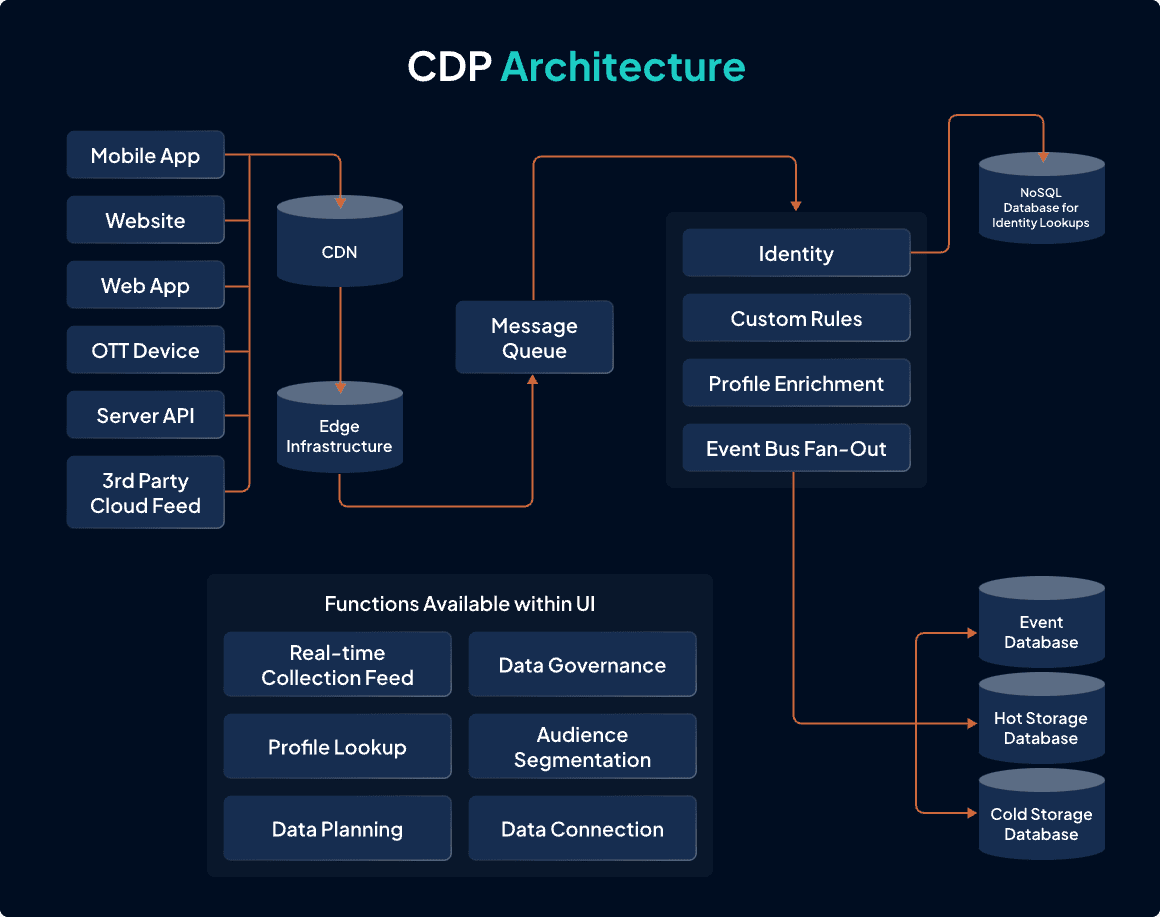
Data Warehouse Architecture
Data warehouse architecture is typically organized into three distinct tiers, each with its specific purpose:
- Front End Client (Swift Presentation Tier)
The first is the top tier is the most open for the users, which includes the BI tools and the SQL clients. It enables users to engage with data, run reports, and analyze data, which makes it easier to make decisions based on data.
- OLAP Server (Middle Tier)
The middle tier includes the Online Analytical Processing (OLAP) server needed for data surfing and analysis in OLAP client applications. It renders rich and sophisticated search capabilities and quantitative analysis to improve and speed up the process of data navigation.
- Database Server (Bottom Tier)
At the lowest level, the database server is responsible for handling the processing of data storage. Data can be stored in:
- Hot Storage: Optimistic solutions such as SSDs for the data with high access frequency.
- Cold Storage: Other more affordable solutions like Amazon S3 for archive data or Tier 3 applications.
This three-tier design enhances the store, control, and analysis of data and provides sound analytical strength.

2. Purpose:
This shows the distinctiveness of their functions based on the primary purpose of each platform.
CDPs’ major objective is established on the development of a customer database that can support the marketing processes and deepen the customer relations. Some of the current technologies help businesses to gather data in real-time, which means that customer messages can be personalized and campaigns can be tailored.
In contrast, the Data Warehouses are more suitable for analytical reporting, business intelligence, and data analysis. They should be informative about historical trends and performance, so omitting them from decision-making processes is unthinkable.
3. Data Types:
The kind of data that each platform processes also makes their differences clear, as discussed next.
CDPs are particularly good with structured and unstructured data, such as behavior, transactional, and demographic data. This capability enables the better understanding of customer behavior, as CDPs indeed augment data with third-party ones.
On the other hand, Data Warehouses are mainly related to structured data from Relational DBMSs and they are used mostly for archive data. Compared to CDPs, however, they are less versatile in terms of handling different types of data – they work best with large datasets.
4. Users:
The target group of each platform is also completely different from the other.
CDPs are ideal for marketing departments, customer experience specialists and data analysts who require valuable information for effective customer interaction. The two possess simplistic designs in the user interfacing, ensuring that marketing departments can work with the data without necessarily requiring technical personnel.
On the other hand, Data Warehouses are employed by data engineers, data analysts, business intelligence professionals who work with complicated queries and data modeling. These platforms are somewhat technical and often it is challenging to get all the data in simple formats that can be easily analyzed.
5. Benefit
CDPs give a full view of the customers, as a result, personalization is fostered besides customer experiences. Their real-time data access and activation features aid in real-time marketing actions, helping in customer interaction and retention efforts.
Data Warehouses, on the other hand, arrange data and knowledge for analyzing large datasets and generate detailed reports. They are useful for accumulating and tracking information over time and providing an employer with overall performance records together with the ability to predict future trends.
Factors to Consider Before Choosing a CDP or Data Warehouse
What to Think About Before You Buy a CDP or a Data Warehouse
- Data Type and Sources: Type of data needs to be handled (structured, unstructured) and the origin of data like Web, Mobile, and third-party data. CDPs outperform in accommodating different kinds of data, while Data Warehouses are better suited to structured information.
- Use Cases and Objectives: Consider your primary goals. If you consider rapid communication and address the customer personally, then it is better to turn to CDPs. If the application of data is more specifically related to data mining, reporting, and data analysis, then Data Warehouse is more appropriate.
- User Accessibility: Consider who is going to use the platform. CDPs are created more for marketing teams and users who are not developers, exposing user interfaces. Data Warehouses usually demand a higher level of technology in order to extract and analyze the data.
- Integration Capabilities: Find out how each solution interacts with your current software and applications. CDPs primarily integrate with multiple marketing and analytical tools effortlessly, whereas Data Warehouses can demand additional integration through ETL.
Conclusion
CDP Vs Data Warehouse has many decisions that can be a game-changer for your business. Given the high degree of customer expectations that have now become the norm, CDPs allow you to make the most of real-time data for customers – every touchpoint matters. On the other hand, Data Warehouses act as large stores of past information best suited for planning and decision making. Depending on your organization’s needs it may be constant customer interaction or On the other hand, data Warehouses provide robust solutions for historical data analysis, essential for informed decision-making and strategic planning.
By evaluating factors such as data types, user accessibility, and integration capabilities, businesses can choose the solution that best fits their needs. complex analysis of data, AI can be integrated to meet all these. The right choice does not only make your marketing better but also changes your whole business approach in today’s world. You make your decision and observe your business grow big!
Sign up for a 14-day free trial and simplify your data integration process. Check out the pricing details to understand which plan fulfills all your business needs.
FAQs
1) Is a CDP the same as a data warehouse?
No, a Customer Data Platform (CDP) and a data warehouse serve different purposes. A CDP focuses on real-time customer data integration and activation, enabling personalized marketing. In contrast, a data warehouse is designed for long-term storage and complex analytics of historical data across various sources.
2) Is a CDP a warehouse?
No, a CDP is not a warehouse. While a CDP is about storing the data, the customer data platform consolidates real-time customer data to build profiles for engagement, and a data warehouse stores the structured data to analyze and report across time. The difference in the work done by these two and the roles they play is clearer.
3) What is the difference between EDW and CDP?
EDW stands for Enterprise Data Warehouse, and it is an integrated system designed to store, analyze and report organizational data drawn primarily from historical sources. By contrast, a Customer Data Platform (CDP) is designed to connect real-time customer data for marketing and immediate actionable insight, for marketing departments and customer interactions.
4) What is the difference between a CDP and a data lake?
A CDP underpins the processing of structured as well as unstructured customer data in real time for the purpose of personalization. But a data lake is merely a large repository of raw data in its most original form that accommodates various types of analysis while not being targeted at customers as a CDP is. Their functions are dissimilar.

